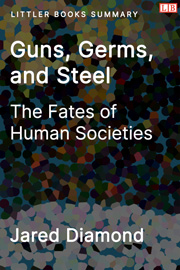Book Description
A Pulitzer Prize-winning book that explains how geography and environmental factors shaped the modern world.
If You Just Remember One Thing
Environmental advantages, not biological differences between peoples, enabled Eurasian societies to develop food production... More
Bullet Point Summary and Quotes
- The book's title refers to how societies conquered others -- with guns, germs, and steel.
- Environmental, not biological factors shaped the differences between societies.
- Eurasia (Asia, Europe, and North Africa) had incidental environmental traits that helped its people achieve dominance.
- Factors of Eurasia's dominance include the development of advanced knowledge, centralized governments, and resilience to infectious diseases, which were all affected by the environment.
- Eurasia had environmental advantages that aided food production.
- Eurasia had more domesticable plants because of its climate.
- The ideal plants of the Fertile Crescent (modern-day Middle East) enabled the earliest independent plant domestication in the world.
- Eurasia had the most domesticable animals due to its large land area and ecology.
- 13 out of the 14 ancient animals suitable for domestication were all in Eurasia.
- Eurasia lost fewer domesticable animal candidates to extinction than other continents.
- Eurasia's east-west axis resulted in insignificant seasonal differences, which enabled crops and animals to spread more easily than north-south axes. Crops can better survive in locations of similar climates, and climates do not differ as much when traveling from east to west, but can change drastically when traveling from north to south.
- Eurasia had less ecological barriers like rainforests and desserts to prevent the spread of agriculture.
- Eurasia had inherent advantages to help the spread of knowledge.
- Eurasia's early agricultural advantages enabled it to support large population densities, which led to the development of specializations (e.g., craftsmen, scholars, soldiers), which led to the invention of written language -- a crucial element in spreading information.
- Hunter-gatherer societies were mostly occupied with finding food for survival.
- Eurasia was by far the largest continent, and its substantial habitable area is more suited for large populations than other continents.
- Similar to plants, humans are unsuited for extreme weather differences, so Eurasia's east-west orientation and paucity in geographic obstructions better enabled people to migrate across the continent. People carried their ideas with them, diffusing knowledge.
- Eurasia had the advantage of centralized governments.
- As a result of Eurasia's larger populations, there were more conflicts between its people, and thus required a more sophisticated and centralized governance.
- Eurasia societies had a need to coordinate complex projects (e.g., irrigation systems, warehouses) to support its agriculture.
- By appealing to a powerful authority or a religious entity, centralized governments were better at organizing large-scale projects and waging wars, and thus became more commonplace in Eurasia.
- Eurasia became immune to infectious diseases earlier.
- Eurasia's high population and food production methods resulted in people's close contact with domesticated animals which enabled microbes to transfer to humans.
- Dense Eurasian cities allowed diseases to spread rapidly.
- Epidemics conferred genetic immunity to Eurasian survivors and their children.
- Eurasians carried deadly germs to other continents and decimated native populations.
- Archaeologists believe up to 95% of Native Americans died from diseases like smallpox brought by Europeans after Columbus's arrival.
Guns, Germs, and Steel: Resources
- Download this summary and 173+ other top nonfiction book summaries in one book (PDF, eBook, DOCX)
- Buy the book
